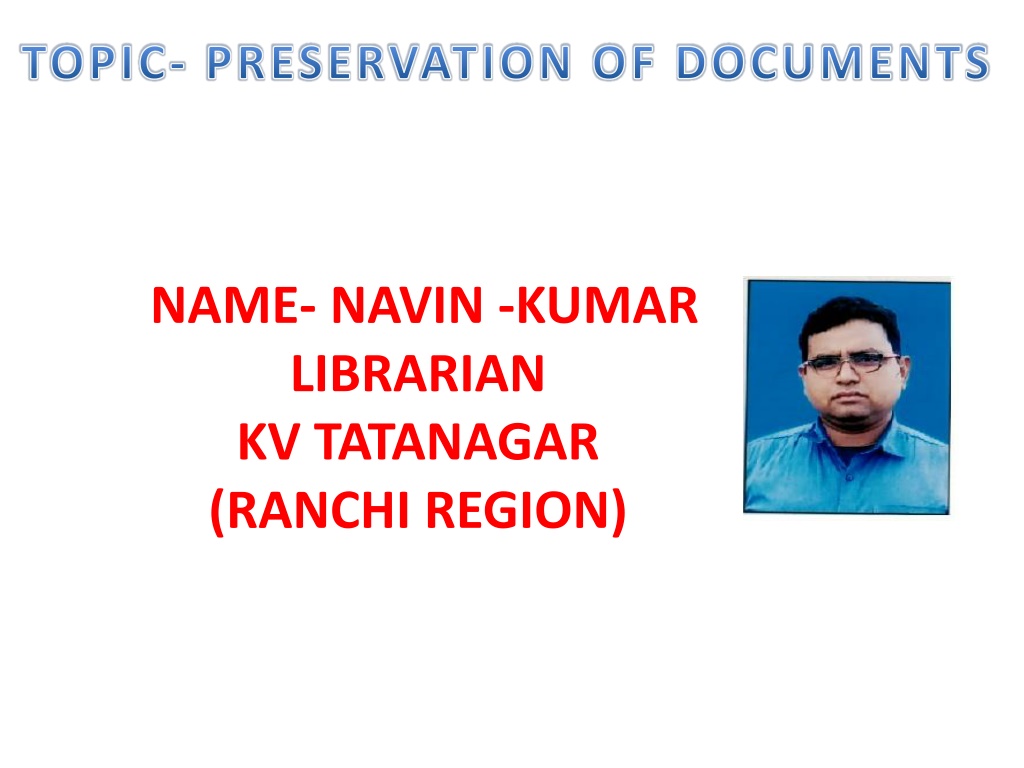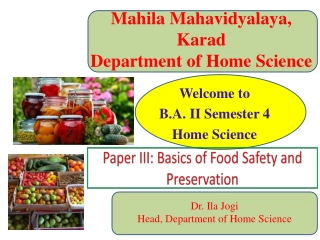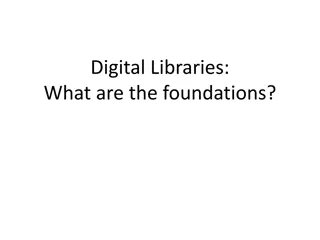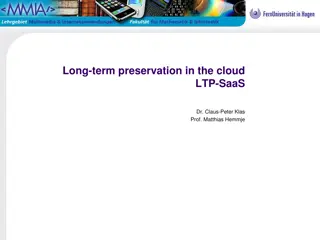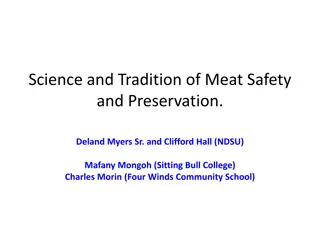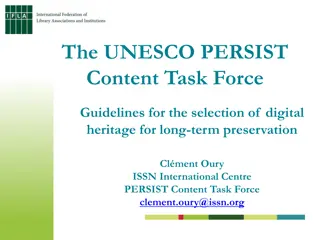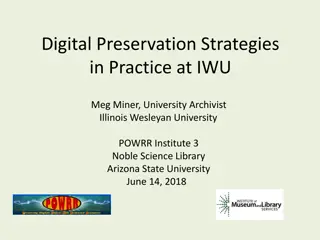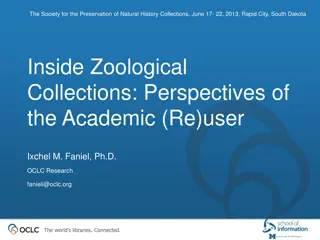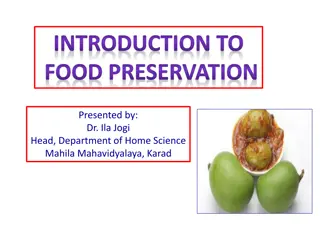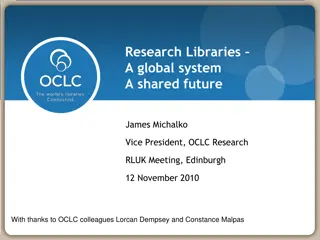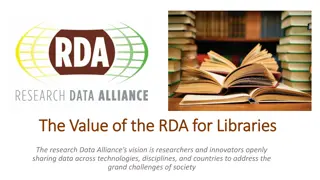Importance of Preservation in Libraries for Future Generations
Preservation in libraries is crucial to protect documents from deterioration caused by various factors like climate and physical damage. The preservation of library materials ensures that valuable cultural records are passed down to future generations for continued access and knowledge dissemination.
Download Presentation

Please find below an Image/Link to download the presentation.
The content on the website is provided AS IS for your information and personal use only. It may not be sold, licensed, or shared on other websites without obtaining consent from the author. Download presentation by click this link. If you encounter any issues during the download, it is possible that the publisher has removed the file from their server.
E N D
Presentation Transcript
TOPIC- PRESERVATION OF DOCUMENTS NAME- NAVIN -KUMAR LIBRARIAN KV TATANAGAR (RANCHI REGION)
Preservation : concepts Preservation means keeping an object away from harmful effects like loss, damage, destruction, mutilation and prolonging its life to whatever extent possible by maintaining it in a reasonably sound condition for present and future use. Without preservation, the knowledge cannot be transmitted to future generations. Preservation system includes determination of the causes of deterioration of documents, to adopt some administrative policy regarding preservation work and implementation of appropriate preservation techniques to maintain the usable condition of the documents.
What are the library document? Generally, libraries have different kinds of materials; mainly paper documents paper documents -text books, reference books, newspapers, maps, charts, atlases, etc and other kinds of non non- -book materials book materials - manuscripts, photographic materials, globes, sound recordings, electronic materials, microdocuments etc. The rate of deterioration of these documents depends directly with the climatic condition of that particular area.
Need of preservation of library document?. The basic objective of a library is to collect, organize, preserve, and provide access to knowledge and information. In fulfilling this objective, libraries preserve a valuable record of culture that can be passed down to succeeding generations. Libraries are an essential link in this communication between the past, present, and future. Whether the cultural record is contained in books or in electronic formats, libraries ensure that the record is preserved and made available for later use. Books are for use Ranganathan s first law of library science emphasises on the dissemination of library materials is possible if the documents are in good condition.
Preservation of Library Materials . Libraries have always struggled against the physical destruction of their collections. Fires, floods, earthquakes, and wars have damaged the holdings of countless libraries, destroying forever much of the recorded history of human civilization. But library materials also fall victim to slow decay caused by acid content in paper, insect infestation, improper storage or handling, and excessive heat, mildew, humidity, and air pollution. The slow decomposition of library materials is a universal problem. To ensure that library materials remain available to present and future generations of library users, libraries engage in a variety of preservation efforts. These efforts include the conservation of original materials and the transfer of information from original materials to more durable formats. Preservation does not simply happen on its own, a well thought out plan must be drawn and managed. According to fifth Law of Library Science Library is a growing organism . Libraries acquire materials of all kinds continuously, and promote the use of these acquired materials. Hence more and more number of users want to access these materials. As more and more number of users use these materials, they are more likely to be damaged. To prevent this deterioration of materials which may affect the further retrieval of the contents, we need to adopt an array of appropriate management strategies. Environmental conditions and methods of storage have a great influence on the preservation of documents. Control of the environmental conditions and the provision of good storage conditions constitute the best preventive measures.
Factors responsible for deterioration of library documents- 1. ENVIROMENTAL FACTORS 2. BIOLOGICAL FACTORS 3. CHEMICAL FACTORS 4. HUMAN FACTORS:- 5. DISASTERS:-
1. ENVIROMENTAL FACTORS :- 1. Light :-Whether natural light or artificial light paper gets deteriorated when it is exposed to light. Especially sun light, has a serious damaging effect on written or printed paper materials. The ultraviolet radiation of light are mainly responsible for photochemical degradation of paper which takes place rapidly when paper is exposed to sun light in presence of air (oxygen). When some portion of cellulose is oxidized to oxycellulose, the long cellulose chains are broken and the paper becomes weak and brittle. Fading of ink and dye of the coloured paper and yellowing of white paper also takes place due to the formation of oxycellulose. Artificial light like fluorescent tube light also radiates a high percentage of ultraviolet rays which cause deterioration by yellowing the paper. How ever the amount of damage by light depends upon the following factors. Intensity of light-as the intensity of light increases the rate of deterioration of the paper also increases. Duration of exposure-the duration of exposure of paper to light is directly proportional to its deterioration. Distance from the source of light-more the distance, less the damage.
1. ENVIROMENTAL FACTORS :- 2.Heat:- Usually the source of heat is high atmospheric temperature. Heat is measured in terms temperature either in Centigrade scale or Fahrenheit scale. High heat with low humidity causes dehydration of cellulose fibers and the paper becomes brittle. It loses its flexibility to the extent that it tends to crumble on touch. On the other hand, high temperature with high humidity creates the condition for the growth of moulds. If electric bulbs are used for lighting purpose, they increase room temperature as high powerful bulbs generate more heat. Besides extreme variation in temperature (say 50c in winter and 450c in summer) affects the physical condition of the library materials. 3.Humidity and Moisture:-Humidity is the amount of moisture in the atmospheric air. The moisture is measured in terms of relative humidity. All organic objects absorbs water to a greater or lower extent and the water goes inside the object through surrounding air. Because of this absorbency property, the paper absorbs more moisture when there is high humidity. Certain amount of humidity is necessary for the flexibility of paper but in prolonged high humid condition, paper becomes soggy and the moisture weakens the fibers of paper. Moisture is the root cause of various types of physical, chemical and biological deterioration of library materials. It weakens the adhesive and makes the book binding loose. It also weakens the sizing elements of paper and causes spreading of ink. Moisten pages of book often stuck together. It also accelerates various types of chemical deterioration as a result of which paper becomes yellow and stained with spots. Moisture also promotes the growth of fungus, which cause damage to paper and book binding materials.
1. ENVIROMENTAL FACTORS :- 3.Dust and Dirt :-Fine dry particles of any matter present in the air are known as dust. Dust, which is highly dangerous for the library and archival collection, composed of soil, tar, metallic substances, fungus spores and moisture among other things. Since dust is air borne it settles down on any surface of the object. Dust is hygroscopic in nature and when it is mixed with high humidity, it is transformed into dirt and if this dirt sticks to the surface of the books, it becomes difficult to remove. Dust and dirt are sources of both physical and chemical degradation of the library collection. Dust acts as a nucleus around which moisture collects and this moisture provides the necessary humidity for the growth of fungus and for chemical reaction, which lead to the formation of acids. Since dust and dirt are solid particles of varying size and hardness they exert abrasion on the surface of the books. 4. Water :-Water occurs in all the normal state of matter- solid, liquid and gas. It acts as a physical agent of deterioration by causing hygroscopic materials to undergo dimensional changes. Water, which is harmful for the library collection may come from sources like natural calamities, human negligence, from leaking roofs, defective plumbing and through open windows at the time of raining. Excessive water brings about biological attack on paper, which is usually manifested as the growth of fungus or mildew. The effects of water are stained paper, rotted leather, smeared ink, weaken adhesive, sustained fungi etc. Water also does injury to the steel furniture due to rusting.
2. BIOLOGICAL FACTORS :-The deterioration caused by biological agents such as micro-organisms, insects and rodents is generally known as bio-deterioration. Almost all book components, be it paper, leather, textiles or straw board used for binding are prone to attacks by these biological agents. The problem of bio-deterioration is a matter of considerable significance of tropical hot and humid climate like India. The climatic condition accelerates the growth and multiplication of living organisms. There is perhaps no library, which has not suffered the ravages of these agents of bio-deterioration. These biological agents can be subdivided into :- (i) Micro-organisms- Fungus or moulds, bacteria etc. (ii) Rodents (iii) Insects
2. BIOLOGICAL FACTORS:- (i)Micro- organisms:- 1. Fungus-Fungus are a large heterogenous group of plant organisms. The fungal spores are present in the earth, water and air and remain in a dormat state for long periods. These spores sprout and grow when they have the required moisture and heat. Generally fungi grow in a relative humidity range of 63-100% and temperature range of 15-350c. In libraries fungal growth is known as mould or mildew and they appear as brown/black vegetative growth on paper, leather and textiles. Fungus consume cellulose and also thrive on nutrients in leather, glues, pastes, binding threads etc. they weaken and stain the paper and can cause discoloration. 2. Bacteria- Besides fungus, bacteria also decompose cellulose in paper and binding textiles. (ii) Rodents Rodents include mice, rats, squirrels and many other species. Mice and rats are mainly found in libraries and they find their way into buildings through dry drains and openings in doors and windows. In libraries they eat and destroy materials made up of paper, cloth, leather, glue, etc. These animals are very swift to move and hide in dark corners.
2. BIOLOGICAL FACTORS:- (iii) Insects:-Even though there are thousands of insects, only certain insects badly damage the archivo-library materials. They are silverfish, cockroaches, booklice, bookworms and termites. 1.Silverfish The main source of these insects are food materials like starch, glue and gelatin which are used in paper as sizing materials. Dust and dirt also attract this insects. They re fond of dark places and are active in nights only. Silverfish do not have wings and are silvery or pearl gray in colour and about 8 to 10 mm. in length. They eat the surface of the paper and also eat gum from postage stamps, envelopes etc. They grow holes in paper, prints, photographs, catalogue cards and cardboard boxes. The dark spaces on the library racks, catalogue cabinets, drawers are the places for their egg laying. 2.Cockroaches cockroaches are common all over the world which are brown or blackish brown in colour. They eat paper leaves, bookbinding, fabrics and other organic materials. They are frequently found in libraries, archives and museums and are very active during the night. They live in corners which are damp, cleavages in walls and floors, behind and beneath almirhas, shelves and in wooden cupboards. They excrete a dark brown liquid, which leave stains on the paper and become difficult to remove. CONT .
2. BIOLOGICAL FACTORS:- (ii) Insects 3.Book worms or Book beetles- Bookworms affect very much books and manuscripts. As the name itself suggests they feed on paper and damage the paper extensively. In libraries the bookworms lay their eggs on the edges of the books and on the surface of the bookbinding. They make tunnels in the pages and boards of the books. 4.. Book lice: - Dark dusty areas filled with unused books, dampness and warmth are essential requirements for the growth of booklice. They are gray or white in colour. They injure the bindings of books by eating paste and glue and also eat the fungus formed in between the edges of inner cover of the books. 5. Termites or White Ants In the tropical climate the damages to the library materials due to termites are much. Wet or damp conditions are most suitable places for termites. They eat wood and paper and can attack any type of material containing cellulose. If once they start destroying the books they can do irreparable damage in no time. They leave mud encrustation on the attacked materials. They are of two categories like earth dwelling termites and wood dwelling termites. Earth dwelling termites live in the soil and in the libraries their presence can be noticedby their mud tunnels on the walls, book cases and furniture. Wood dwelling termites live above the ground and enter the building through cracks and openings.
3. CHEMICAL FACTORS:- In the manufacturing of paper sometimes fibers are used with low cellulose contents and some chemical compounds like alum, rosin etc. are used for sizing of paper which cause acidic effect and facilitate chemical deterioration of the paper with the passage of time. Besides, in the atmosphere among various constituents unwanted materials such as oxides of carbon, sulphur, nitrogen and hydrogen sulphides are also present. Because of the absorption of the chemicals by the moisture absorbed by the paper, the library materials get affected. The notable deleterious substances for the library materials are sulphur dioxides, oxides of nitrogen and ozone. Sulphur dioxide is a hazard to cellulose materials like paper and cloth. The most familiar effect in libraries is the brown and brittle edges of books caused by sulphur dioxide. Most of the nitrogen dioxide comes from automobile exhausts & when it combines with oxygen and water turns into nitric acid. This nitric acid has strong acidic effects and attacks the dyes in ink, cloth, paper and leather. Ozone acts as a powerful destroyer of organic materials. It makes the colours of fabric book covers fade and the book binding materials such as leather, gelatin, glue and paste are also susceptible to deterioration by ozone in humid atmosphere.
4. HUMAN FACTORS:- Apart from physical and chemical factors, a serious cause of deterioration often is the casual attitude of the library staff as well as the users of the library towards books as physical objects. Librarians in charge of the documentary heritage are directly responsible for the overall conservation and preservation of their collections. But they are not always aware how to handle, store and use collections carefully to minimize damage and help preservation. The standard of care and handling of books by their custodians and users is often pretty low. Improper storage, faulty repairment, rough handling, deliberate abuse, folding the fore-edges of pages as a mark of reading, marking by ball pen, mutilation, vandalism are all examples of deterioration of books by human beings. 5. DISASTERS:- No library is exempted to the devastations that can occur as a result of natural or man made disasters. In libraries, archives and museums there is a likely-hood of fire as the collections are mostly organic in nature. Once fire starts, it is difficult to save those materials which get fire. Items not directly engulfed in flames can be charred by soot and smoke. Heat emitted from fire causes bindings to shrink and warp and plastic base materials to melt. Water used for fighting fire can cause enormous damage. Besides fire, floods, high winds, cyclones, earth quakes are also agents of deterioration for the library collections. These will lead documents to absorb water, swell, warp and become extremely vulnerable to physical damage. Dyes and ink may bleed and book pages stick together. Leather bindings seriously warp and change shape. Effects of disasters on library collections are too obvious to comprehend.
Techniques of preservation -Conservation work is the sum total of preservation and restoration work. The total conservation work can be divided into four steps. 1) Examination of the documents, 2) Preventive conservation, 3) Curative conservation 4) Restorative conservation.
PREVENTIVE MEASURES FOR ENVIRONMENTAL FACTORS:- Control of environmental factors partially begins from selection of site, the planning and the construction of the library building and also the soil on which it will be constructed because these elements have greater impact over the environmental control inside the library building. It is very important to choose the best architectural design for the library having cross ventilation facilities for free air circulation within the building. If there is a need to use wooden materials, the wood selected should be well seasoned and must be treated chemically to avoid insects. Growth of plants near the building must be avoided, as the roots will damage the building foundation. It is always better to construct the building away from traffic to avoid dust and dirt. Provision of adequate number of electric fans and few exhaust fans will facilitate air circulation inside the library. Sunlight should be prevented from falling directly on papers because the sun is a great emitter of ultraviolet rays. The windows must be provided with colored curtains, which will prevent falling of direct light as well as absorb ultraviolet rays. Lemon yellow or green coloured glass panes should be fitted in window panes as these are more effective in blocking ultraviolet rays. It is extremely good to fit acrylic plastic sheet in the panes of window because it filters out UV rays to a greater extent than coloured glass. The UV rays of fluorescent tubes should be filtered by covering the tubes. As high humidity and high temperature are more hazardous for library materials it is advisable to maintain ideal room temperature (200-250c) and relative humidity of (RH45- 55%) for preservation of documents.
PREVENTIVE MEASURES FOR ENVIRONMENTAL FACTORS:- CONT . Air conditioning of the stack area round the clock is an ideal example of maintaining optimum temperature & humidity for the storage of documents. But it is practically not possible for all the libraries to afford for air conditioning for 24 hours. So it is useful to adopt local control measures like use of humidifiers in dry climate to increase required level of moisture content and dehumidifiers to remove moisture in wet seasons. These may be operated whenever necessary for which proper monitoring of relative humidity is highly essential. High humidity could also be minimized by the use of de-hydrating agents like silica gel. The requisite quantities of silica gel may be spread in dishes and kept in different places in the room. After the use for 3-4 hours the silica gel may get saturated and may need replacement with fresh gels, while the saturated gel can be reactivated for further use after heating it in open pans. During the summer months when the temperature is high the windows should be kept closed. If the windows are to be kept open wet curtain should be used. High speed air circulators also be used for free air circulation. Floors can be cleaned by wet dusters. As accumulation of dust and dirt accelerate the physical damage of books, a cleaning schedule should be made considering the sequence of operations following daily and weekly routines. Specific instructions should be given to clean remote corners of the book shelves, behind cabinets, under desks, chairs, and all surfaces accumulating dust. The best way is to use a vacuum cleaner because it sucks the dust and can not resettle on the surfaces.
PREVENTIVE MEASURES FOR BIOLOGICAL FACTORS:- Since stagnant air, dampness, dark and dingy places in a library facilitate the growth of biological pests, good housekeeping and maintenance of optimum storage condition is necessary to control the propagation of the insects. Provision of cross windows, ventilators, exhaust fans ensures good circulation of air but at times it is necessary to circulate the air inside the room with electric fans. It is preferable to avoid contact of book racks with walls (at least 15 cm away from the walls) to eliminate dampness. Attending to cracks, crevices and loose joints in floors and walls eliminate the possibility of insect hiding in these places. Presence of edibles inside the library should not be allowed. Periodic use of insecticidal powder of solution like lindane at the dark corner walls, beneath the racks and almirahs is a good precautionary measure to prevent insects. It is safe to use paradichloro-benzene as it acts both as an insect repellent and insecticide. A simple practice is to keep naphthalene bricks on the shelves as it repels the insects from coming to the book racks. Dry neem leaves, neem seed powder and camphor tablets tied in muslin bags should be kept inside the racks for keeping the pests away. The foundation of all the new library buildings should be given anti-insect treatment
PREVENTIVE MEASURES FOR CHEMICAL FACTORS: If the air pollution is controlled there will not be any external acidity in the paper materials. One of the best ways of controlling atmospheric pollutants is filtering of the air intake in to storage areas, which can be attained by air conditioning system operating for 24 hours throughout the year. Without this facility simple measures like wrapping the books and manuscripts in cloth or placing them in book containers reduces the effects of pollution to a great extent. The books kept inside cupboards are better protected than those which are kept outside. Documents kept inside folders are safer than those which are kept in the open. Proper care should be taken to save books and documents from dust. It is preferable to use vacuum cleaner and fine brushes for dusting of shelves and books. No chemical formulations should be directly applied on to the book covers, since these may have an adverse effect on the books as well as users of the books and staff of the library. Wooden storage should be avoided as it gives off volatile acidic vapours. If it is to be used it must be covered with coats of acrylic emulsion paint. Besides, acid free paper, board and good quality materials should be used for repair and restoration of documents.
PREVENTIVE MESURES FOR HUMAN FACTORS:- There are certain do s and don ts which the library staff and the users should follow to increase the longevity of the library resources. These are among others: - i. Important books and manuscripts should kept in specially prepared containers. ii. For carrying a large number of books trolleys should be used. Utmost care should be taken while transporting rare, valuable and delicate books. iii. Care should be taken while photocopying the books as at that time considerable stress is imposed on the material and the bindings suffer most and also the spine damages. iv. Use bookends to support books when shelves are not full. Books should not be shelved too tightly or too loosely. v. It must be always ensured while opening the books, pages are not torn or covers are not damaged. To turn a page lift the top corner and lightly slip the finger tips down the fore-edge supporting the page. vi. Pages should never be folded otherwise creases will be formed and they may be torn at the folds. Corner of pages should not be folded to mark pages. vii. Avoid licking of fingers as an aid to turn pages. viii. Underlining must be avoided. ix. Books should not be left open on the reading table, face downwards. x. Leaning on an open book should be avoided since this can damage the spine and binding. xi. Never allow a book to stand on its fore edge. xii. When a book is displayed open, never use metal clips or pins to hold book pages open.
DISASTER PREPAREDNESS:- Disasters are generally unexpected events with destructive consequences to a collection. Therefore it is vital for any library to take every possible precautions to prevent the occurrence of an unavoidable disaster. A disaster planning is an essential element of preventive conservation. It is also necessary to identify any external and internal threats that might cause problems for the collection and measures to meet those threats. Without an existing disaster preparedness plan or crisis management plan, the librarians will be unable to act quickly to organise salvage efforts. It should be mandatory for every library to have a written disaster preparedness and response plan containing description of emergency procedures, emergency supplies list, disaster response outline, conservation experts, list of staff volunteers, list of external contacts and names, addresses, home and work telephone numbers of personnel with emergency responsibilities. Besides libraries should be provided with fire and smoke detection system and automatic fire extinguishing system. Use of match stick or open flame and smoking should strictly prohibited inside the library. Inflammable materials and chemicals should not be stored inside the stacks. The telephone number of the fire office should be visibly and clearly exhibited. Location of emergency gate must be clearly indicated. The electrical defects and faults should be set right in time.
Preservation Program in BARC Library BARC library has a well planned preservation program which includes the following: The library is centrally air conditioned and monitored regularly, Cleaning of library shelves is done on regular basis using modern gadgets, Periodic (monthly) spraying of pesticides by Landscape and Cosmetic Section, Smoke detectors have been installed to prevent any damage to library collection, Regular training in fire fighting is given to all staff members, User education is provided on how to handle library materials, Regularly inspect the water supply joints to find out water leakage, Security personnel at the entrance screens the checked out library items, and Telephone numbers of all the vital installations such as security, hospital, fire fighting unit have been printed in the yearly pocket calendars and supplied to all employees.
CONCLUSION There is an old adage that Prevention is better than Cure . The same is true for the science of preservation. The concept of preservation is now gradually becoming a central issue in modern librarianship and preventive conservation, plays a key role in preserving the documentary heritage for Posterity. Therefore in every library at least preventive conservation should be practised to keep the documents in healthy, good and usable condition.
THANKS FOR WATCHING BY-BY
